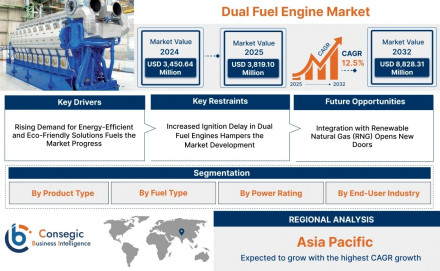Dual Fuel Engine Market Trends and Opportunities (2025–2032)

Dual Fuel Engine Market Size:
Dual Fuel Engine Market size is estimated to reach over USD 8,828.31 Million by 2032 from a value of USD 3,450.64 Million in 2024 and is projected to grow by USD 3,819.10 Million in 2025, growing at a CAGR of 12.5% from 2025 to 2032.
Dual Fuel Engine Market Overview:
The global dual fuel engine market is witnessing steady growth, driven by the increasing adoption of cleaner and more efficient fuel technologies. This market is expanding due to the growing need to reduce carbon emissions, volatile fuel prices, and the need for energy security. Industrial applications such as marine propulsion systems, power plants, mining, and heavy-duty vehicles are major contributors to this market. Dual fuel technology is especially appealing in regions where access to natural gas infrastructure is improving. The integration of smart control systems, ongoing R&D in combustion efficiency, and supportive government regulations are also shaping market dynamics.
Dual Fuel Engine Market Includes Drivers, Restraints & Opportunities
Key Drivers:
- Environmental Regulations: Stricter global emission norms and sustainability goals are encouraging the adoption of cleaner engine technologies like dual fuel engines.
- Cost Efficiency: The ability to switch between diesel and cheaper natural gas offers significant cost savings, especially in high fuel consumption applications.
- Energy Security: Dual fuel engines offer greater energy flexibility by reducing dependency on a single type of fuel, enhancing energy security.
- Growing Marine and Industrial Applications: The maritime industry, driven by IMO emission standards, is adopting dual fuel engines for ships to meet sustainability targets.
- Technological Advancements: Improvements in engine control systems and fuel mixing technologies are enhancing performance and adoption rates.
Key Restraints:
- High Initial Costs: Dual fuel engines are generally more expensive to produce and install than conventional engines.
- Infrastructure Limitations: The limited availability of natural gas refueling infrastructure, especially in developing regions, hinders widespread adoption.
- Complexity in Operation and Maintenance: Dual fuel systems are technically more complex, requiring specialized maintenance and operational expertise.
- Inconsistent Fuel Supply: Fluctuations in the availability and pricing of natural gas can disrupt operations and profitability.
Future Opportunities:
- Expansion in Emerging Markets: Rapid industrialization and energy demands in Asia-Pacific, Africa, and Latin America create new markets for dual fuel engines.
- Renewable Integration: Hybrid models incorporating renewable fuels (e.g., bio-CNG with diesel) offer promising opportunities for eco-friendly solutions.
- Government Support: Policy incentives for cleaner technologies and investment in natural gas infrastructure can unlock significant market potential.
- Adoption in Power Generation: As grid reliability and decentralization grow in importance, dual fuel engines present an ideal solution for backup and remote power generation.
Dual Fuel Engine Market Competitive Landscape Analysis (Key Players)
- Wärtsilä Corporation (Finland)
- MAN Energy Solutions (Germany)
- Rolls-Royce Holdings plc (UK)
- General Electric Company (USA)
- Kawasaki Heavy Industries, Ltd. (Japan)
- Caterpillar Inc. (USA)
- Cummins Inc. (USA)
- Yanmar Co., Ltd. (Japan)
- Mitsui E&S Holdings Co., Ltd. (Japan)
- Hyundai Heavy Industries Co., Ltd. (South Korea)
Dual Fuel Engine Market Industry Segmentation:
By Product Type
- Four-Stroke Dual Fuel Engine
- Two-Stroke Dual Fuel Engine
By Fuel Type
- Diesel & Natural Gas
- Diesel & Biofuel
- Gasoline & Natural Gas
- Others
By Power Rating
- Below 1 MW
- 1–5 MW
- 5–10 MW
- Above 10 MW
By End-Use Industry
- Oil & Gas
- Transportation
- Automotive
- Others
By Region
- Asia-Pacific
- Europe
- North America
- Latin America
- Middle East & Africa
Regional Analysis of the Dual Fuel Engine Market:
- North America: Significant adoption in power generation and mining sectors, backed by natural gas abundance and emission regulations.
- Europe: Leading in marine dual fuel engine adoption due to stringent emission rules (e.g., IMO 2020), especially in Northern and Western Europe.
- Asia-Pacific: Rapid industrialization, expanding shipping industry, and government support in China, India, and Southeast Asia are driving market expansion.
- Middle East & Africa: Growing demand for decentralized energy solutions and rising investments in LNG infrastructure are supporting growth.
- Latin America: Emerging opportunities in remote power applications and heavy transportation sectors.
Dual Fuel Engine Market Recent Developments:
- Wärtsilä launched a new generation of dual fuel engines with reduced methane slip and enhanced fuel efficiency in 2024.
- MAN Energy Solutions announced new contracts for LNG-powered vessels using its dual fuel engines to meet IMO compliance.
- Caterpillar introduced a modular dual fuel engine for off-grid power generation projects in developing countries.
- Strategic collaborations between engine OEMs and gas infrastructure providers are rising to overcome fuel availability issues.
- Governments in Asia and Europe have introduced subsidies and infrastructure plans to support LNG refueling stations, enhancing dual fuel adoption.
Contact us:
Consegic Business intelligence Pvt Ltd.
Contact no: (US) (505) 715-4344
Email: sales@consegicbusinessintelligence.com

